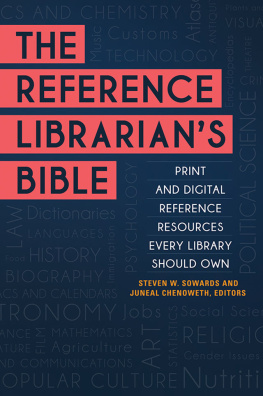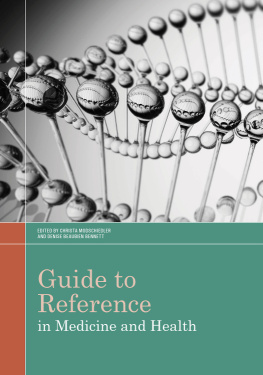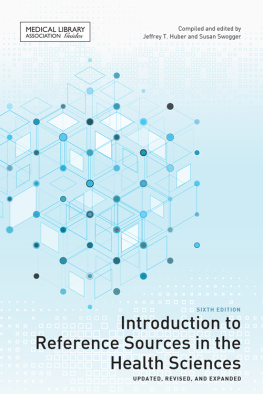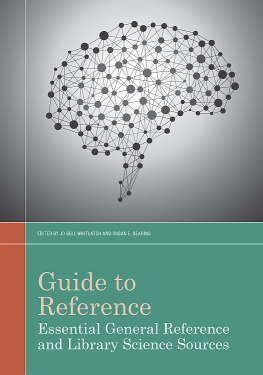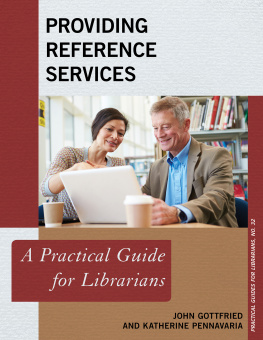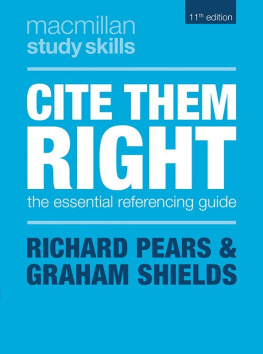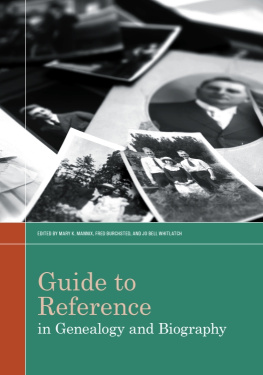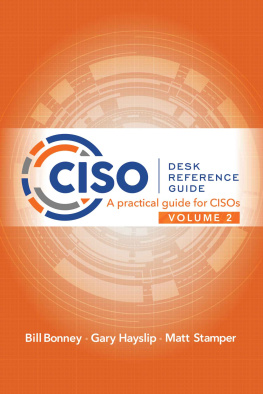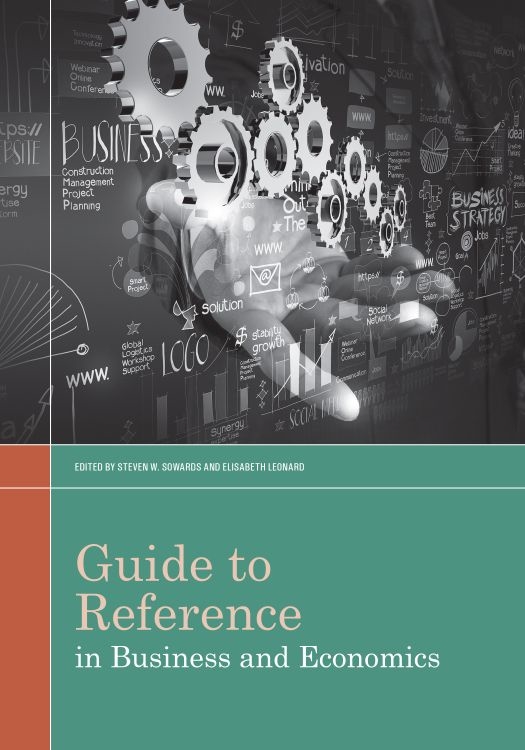
ALA Editions purchases fund advocacy, awareness, and accreditation programs for library professionals worldwide.
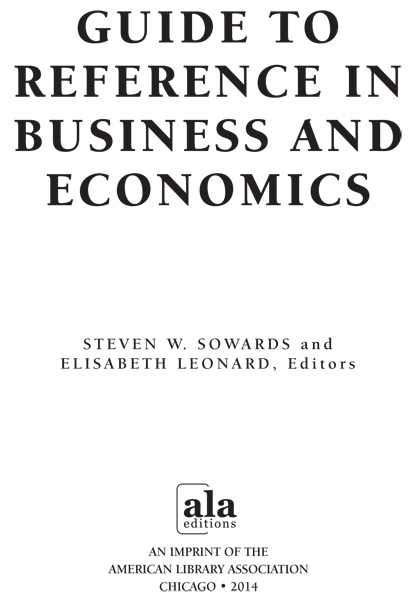
2014 by the American Library Association
Extensive effort has gone into ensuring the reliability of the information in this book; however, the publisher makes no warranty, express or implied, with respect to the material contained herein.
ISBNs: 978-0-8389-1234-8 (paper); 978-0-8389-9634-8 (PDF); 978-0-8389-9635-5 (ePub); 978-0-8389-9636-2 (Kindle). For more information on digital formats, visit the ALA Store at alastore.ala.org and select eEditions.
Library of Congress Cataloging-in-Publication Data
Guide to reference in business and economics / Steven W. Sowards and Elisabeth Leonard, editors.
pages cm
Includes bibliographical references and .
1. BusinessBibliography. 2. BusinessReference booksBibliography. 3. BusinessComputer network resources. 4. EconomicsBibliography. 5. EconomicsReference booksBibliography. 6. EconomicsComputer network resources. 7. Business libraries. 8. Economics libraries. I. Sowards, Steven W. II. Leonard, Elisabeth.
Z7164.C81G85 2014
[HF1008]
016.33dc23 2014022113
Cover design by Alejandra Diaz. Image everything possible / Shutterstock, Inc.
Contents
Steven W. Sowards
Elisabeth Leonard, formerly Associate Dean of Library Services at Western Carolina University, served as the primary Contributor for the Economics and Business section of the online Guide from 2006 to 2012. This 2014 edition builds on her extensive work in selection, organization, explanation, and writing, which supported the 2008 launch of the online Guide.
Steven W. Sowards, Associate Director for Collections at the Michigan State University Libraries and the Guides Division Editor for the Social Sciences since 2005, reviewed and updated entries for this print format edition.
This volume is a tool for librarians and library staff who are selecting economics and business titles for library collections, or answering business questions at the reference desk; LIS students learning about core tools in these areas; and library users seeking the best resources. The potential audience among library users includes not only students and academic researchers, but also professional and business persons, and individuals educating themselves about investments, mortgages, or the functioning of a global 21st-century economy.
The content is based on the Economics and Business portion of ALAs online Guide to Reference (www.guidetoreference.org), a database that descends from volumes in the long-running series Guide to Reference books edited in turn by Alice Kroeger, Isadore Mudge, Constance Winchell, Eugene Sheehy, and Robert Balay, beginning in 1902 and concluding in a print format with the 11th edition of 1996. The online version became available in 2008 under the direction of Robert Kieft. The move to an online Guide reflected the transformation of reference services because of the World Wide Web and digital publishing. A database format offers the potential for continuous editing and revision of the Guide, by recording changes in URLs for online tools, publisher acquisition of titles or imprints, and the release of updated editions of older titles, as well as addition of new works. The database format also makes it possible to publish segments in print or e-book format, and to incorporate user participation through online feedback.
The Guide to Reference is selective: the Business and Economics section presents more than 800 individual entries, chosen for potential value. Entries offer summary bibliographic information, a descriptive annotation, an ISBN for printed works, and a URL pointing directly to online content if possible, or if not, leading to the publishers website. In the table of contents, entries are grouped under major headings, such as General works or Company information. Each section includes more specific categories: some such as Dictionaries or Internet resources reflect format, while others such as Motor vehicles or Biotechnology reflect economic or industrial sectors. Titles may be assigned to more than one section; in such cases, the entry is repeated in full to allow easy browsing and comparison to other resources, without the trouble of following cross-references. Examples include International historical statistics: Africa, Asia & Oceania, 17502005 with statistics from multiple geographic regions, and the Hoovers online site or IBISWorld United States with reports covering multiple companies and industry sectors. An index of titles supports known-item searching, and includes titles and alternative titles noted in the annotations.
Much has happened in business reference publishing since 2008. First, the trend toward online access accelerated: materials budget expenditures in libraries serving graduate business schools, in particular, now are weighted heavily toward online tools that offer 24/7 remote access, multiple simultaneous users, and interactive features. Second, the growth of websites and other digital tools made a number of publications obsolete, especially traditional directories and bibliographies. Third, the financial crisis of 2008 and the resulting recession put a number of publications out of business as budgets and sales contracted. Some well-known resources ceased, including government publications. For example, the Statistical Abstract of the United States was the victim of congressional budget-cutting, only to be revived by a publisher. Entries remain in the Guide for many ceased titles: long back-runs with potentially useful information are still found on library shelves, and it may be helpful for selectors and acquisitions staff to realize that no future editions will appear for some well-known titles, such as the Rand McNally Commercial Atlas and Marketing Guide.
Volatility in publishing makes it hard to stay current with business reference resources. Publishers buy and sell publications, sometimes change product names, or may publish unlike content under similar titles. Annotations in the Guide may record both old and new names, so that a search in the under either title will lead to the current entry. An example is Passport GMID, still recognized by many librarians under its earlier name as Euromonitor. URLs often change because of sale of a product to another publisher or reorganization of server addresses. URLs were checked during preparation of this volume, but further changes are inevitable: in most cases, searching in the online Guide to Reference or on the Web by product title and publisher name will lead to a current URL.
This updated Guide offers expanded coverage for topics of recent interest. New or enriched content covers the financial crisis of 2008 and the resulting recession, unions and human resources, real estate and mortgages, consumer information, Islamic economics, entrepreneurship, and trade with the three largest trading partners of the United States (Canada, China, and Mexico).
The reference tools for business and economics are extensive and complex. In addition to the usual array of publication typesdictionaries, indexes, statistical compilations, and othersthis literature reflects geographical regions (such as North America or Asia), functional activities that take place in all businesses (such as human resources or accounting), and specialized information tools that serve specific industry sectors (such as transportation or retail). These factors are recognized in the design of chapters and sections. A few comments may help readers anticipate the kind of information to be found in various parts of the
Next page

